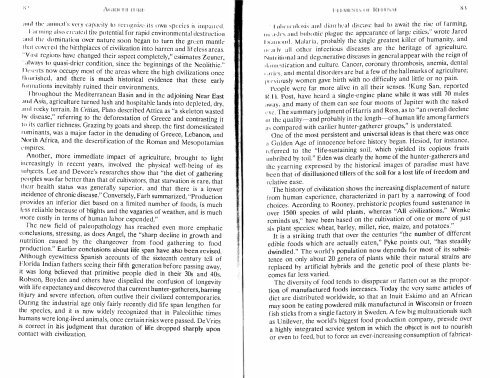CONTENTS - ouroboros ponderosa
CONTENTS - ouroboros ponderosa
CONTENTS - ouroboros ponderosa
Create successful ePaper yourself
Turn your PDF publications into a flip-book with our unique Google optimized e-Paper software.
, ,<br />
. .<br />
;1I11 lilt,. ;lIIilll;tl',..; very (:apacily to nX(lgllizt; its ()wn species is impaired.<br />
i ;lrlllJlIg ;ds() created tllL: potential for rapid environmental destructi()11<br />
;Jlld the domi nation over nature soon bcgan to turn the gn.:cn mantle<br />
111,11 wvered the birthplaces of civilization into harren and lifeless areas.<br />
"Vast regions have changed their aspect completely," estimates Zeuner.<br />
" "Iways to 4uasi-drier condition, since the beginnings of the Neolithic."<br />
t ksnts now occupy most of the areas where the high civilizations once<br />
rr. > Lll islwd, and there is much historical evidence that these early<br />
Ie lrlllations inevitably ruined their environments.<br />
Throughout thc Mediterranean Basin and in the adjoining Near East<br />
",,,I Asia, agriculture turned lush and hospitable lands into dcplcted, dry,<br />
,,,,,I rocky terrain. In Crilias, Plato described Attica as "a skeleton wasted<br />
hy disease," referring to the deforestation of Greece and contrasting it<br />
t(l ,ts earher fIchness. Grazing by goats and sheep, thc first domesticated<br />
,uminants, was a major factor in the denuding of Greece, Lebanon, and<br />
:'>/orth Africa, and the desertitication of the Roman and Mesopotamian<br />
l'mplrcs.<br />
.<br />
Another, Iore immediate impact of agriculture, brought to light<br />
'lIcreasIngly 10 recent years, involved the physical well-being of its<br />
sllbJeets. Ltc and Dtvore's researches show that "the diet of gathering<br />
"copies was far bcttcr than that of cultivators, that starvation is rare, that<br />
lhe,r health status was generally superior, and that there is a lower<br />
incidence of chronic disease." Conversely, Farb summarized, "Production<br />
provides an inferior diet based on a limited number of foods is much<br />
less reliable because of blights and the vagaries of weather, and is much<br />
more costly in terms of human labor expended."<br />
Thc new field of paleopathology has reached even more emphatic<br />
wnc1uslOns, stressIng, as docs Angel, the "sharp decline in growth and<br />
Ilutnl!on caused by the changeover from food gathering to food<br />
production." Earlier conclusions about life span have also been revised.<br />
Ithough eyewitness Spanish accounts of the sixteenth century tell of<br />
I'londa Indian fathers seeing their fifth generation before passing away,<br />
It was long beheved that primitive people died in their 30s and 40s.<br />
Robson, Boyden and others have dispelled the confusion of longevity<br />
WIth hfe expectancy and discovered that current hunter-gathcrers, barring<br />
injury and severe mtectlOn, often outlive their civilized contemporaries.<br />
Dunng tne mdustrial age only fairly recently did life span lengthen for<br />
the speCIes, and It IS now widely recognized that in Paleolithic times<br />
humans wre long-lived animals, once certain risks were passed. De Vries<br />
IS correct In hiS Judgment that duration of life dropped sharply upon<br />
contact with civilization.<br />
. I,dwlnd()sis and diarrheal disc:.tsc had to await the risc of farming,<br />
11H";ISks alld hubonic plague the appearance of large cities," wrot Jared<br />
I ) """. ""I. Malaria. probably the single greatest killer of humanrty, and<br />
)"·,,, Iv all other infectious diseases are thc heritage of agriculture.<br />
N"I ,itional and degenerativc diseases in general appear with the reign of<br />
d, Il nestication and culture. Cancer, coronary thrombosis, anemia, dental<br />
• . " il's, and mental disorders arc but a few of the hallmarks of agriculture;<br />
I " l'Viously women gave birth with no difficulty and little or no pain.<br />
!'eople were far more alive in all their senses. !Kung San, reportcd<br />
IU I. Post, have heard a single-engine plane while It was stili 70 m,les<br />
"way, and many of them can see four moons at JupIter WIth the naked<br />
·<br />
('ye. The summary judgment of Harris and Ross, as to "an overall declIne<br />
'" the qualityand probably in the lengthof human life among farmers<br />
as compared with earlier hunter-gatherer groups," is understated.<br />
One of the most persistent and universal ideas is that there was once<br />
" Golden Age of innocence before history began. Hesiod, fo instance,<br />
,eferred to the "life-sustaining soil, which yielded its COpiOUS fruIts<br />
""hribcd by toiL" Eden was clearly the home of the hunter gatherers and<br />
the yearning expressed by thc historical images ot p . aradlse must have<br />
heen that of disillusioned tillers of the soil for a lost hfe of treedom and<br />
relative ease.<br />
The historv of civilization shows the increasing displacement of nature<br />
from huma; experience, characterized in part by a narrowing of food<br />
choices. According to Rooney, prehistoric peoples found sustenance 10<br />
over 1500 species of wild plants , whereas "All civilizations," Wenkc<br />
reminds us," have been based on the cultivation of one or more of Just<br />
six plant species: wheat, barley, millet, rice, maize, and potatos . . "<br />
It is a striking truth that over the centuries "the number ot different<br />
edible foods which are actually eaten," Pykc points out, "has steadily<br />
dwindled." The world's population now depends for most of its subsis<br />
tence on only about 20 genera of plants while their natural strarns are<br />
replaced by artificial hybrids and the genetic pool of these plants be<br />
comes far less varied.<br />
The diversity of food tends to disappear or tlatten out as the propor<br />
tion of manufactured foods increases. Today the very same arhcies of<br />
diet are distrihuted worldwide, so that an Inuit Eskimo and an African<br />
may soon be eating powdered milk manufactured in Wisconsi or frozen<br />
fish sticks from a single factory in Sweden. A lew big multlllationals such<br />
as Unilever the world's biggest food production company, preSIde over<br />
a highly intgrated scrvice system in which the ohject is not to nourish<br />
or even to feed, but to force an ever-increasing consumphon of tabncat-<br />
S \






